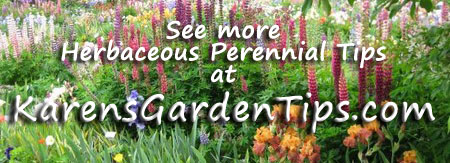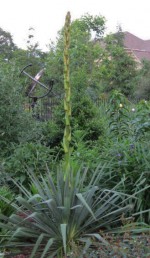 Sometimes you want a spectacular plant to make a statement, serve as a focal point, or add uniqueness to the border. The plant must be outstanding in some way; the color of its flower, the form, size or texture of its leaves, or the shear size of the whole plant. Many characteristics can make a plant stand out in the crowd or stand alone in a bed of its own. Here are five of my favorites.
Sometimes you want a spectacular plant to make a statement, serve as a focal point, or add uniqueness to the border. The plant must be outstanding in some way; the color of its flower, the form, size or texture of its leaves, or the shear size of the whole plant. Many characteristics can make a plant stand out in the crowd or stand alone in a bed of its own. Here are five of my favorites.
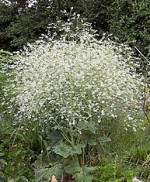
 Colewort (Crambe cordifolia)
Colewort (Crambe cordifolia)
A lover of moisture and cool weather, colewort is a knock out when displays its fragrant cloud of white flowers on widely branching stems over its large, crinkled, deeply lobed leaves below. This is not a plant for the deep south as it does not do well in heat and humidity. Its leaves look poorly if the soil drys out and it should not be moved once established because of its tap root. Still, it puts on quite a show for several weeks and is worth pampering if you have the right climate for it.
-
Size: 4-7’ H x 3-4’ W.
Bloom: Small creamy white flowers are produced in a cloud like effect in summer.
Light: Full sun to partial shade.
Soil: Deep fertile, moist, well drained.
Hardiness: Zones 5-8.
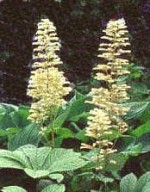
 Fingerleaf Rodgersia (Rodgersia aesculifolia)
Fingerleaf Rodgersia (Rodgersia aesculifolia)
At my age wrinkles are an accepted fact of life but I actually love the wrinkled look of the gorgeous leaves of rodgersia. The coarsely toothed compound leaves 7” across resemble those of horse-chestnut (giving the plant its species name aesculifolia), and are composed of 7 leaflets. They form a clump beneath the tall flowering stalks that arise in late spring bearing small white or pink flowers in clusters up to 24” long. Shaggy brown hair covers the flower stalk, the stem like structures bearing the leaves (petioles) and the main veins of the leaves. The genus name was derived from the name of Admiral John Rogers, the American commander of the ship that went to China and Japan where Rodgersia podophylla was first found.
-
Size: 3-5’ H x 3-5’ W.
Bloom: Small creamy white or pink small flowers are borne in panicles in late spring.
Light: Part shade.
Soil: Rich, humusy, and moist.
Hardiness: Zones 5-7.
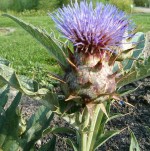
 Cardoon (Cynara cardunculus)
Cardoon (Cynara cardunculus)
This Mediterranean native is eye-catching whether the plant is in bloom or not. The large leaves are silver-gray above, white and wooly below, and bear substantial spines. They are deeply lobed and coarsely toothed, and form a magnificent clump beneath the fragrant purple-blue flowers with spiny bracts. The flowers are good in both fresh and dried arrangements. A relative of globe artichokes, its leaf stalks and midribs are edible.
-
Size: 3-6’ H x 1-3’ W.
Bloom: Purple, thistle like flowers.
Light: Full sun.
Soil: Rich, well drained.
Hardiness: Zones 7-10.
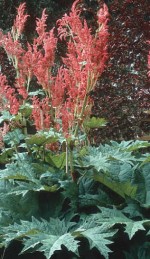
 Ornamental Rhubarb (Rheum palmatum ‘Atrosanguineum’)
Ornamental Rhubarb (Rheum palmatum ‘Atrosanguineum’)
If you want to have a bold plant with touches of red, ornamental rhubarb is a great choice. There is red at various stages of its development but never so much that the color dominates the scene; it just adds to the interest of this fabulous plant. In spring the young leaves are red and as they mature to green above, the undersides retain some red color. In early summer pink to red flowers arise on tall branched stems and later mature into attractive fruit. Even if their were no flowers, the leaves would be worth growing the plant; they are large (2-3’ across), rounded, and deeply lobed and toothed. Simply gorgeous but, alas, not tolerant of heat.
-
Size: 6-10’ H x 4-6’ W.
Bloom: Clusters of small pink to red flowers borne in early summer.
Light: Sun to part sun.
Soil: Deep, organically rich, and moist.
Hardiness: Zones 5-9.
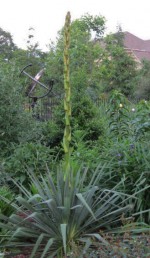
 Adam’s Needle (Yucca filamentosa)
Adam’s Needle (Yucca filamentosa)
The clump of gray-green sword like leaves is a bold statement by itself but when it puts up its flowering stalk in summer “WOW” is the only word for it. The huge stalk towers over the clump of leaves covered with 2’ bell shaped flowers and remain for several weeks. A striking contrast can be achieved by planting soft lamb’s ear next to yucca.
-
Size: 3-5’ H x 3-4’ W.
Bloom: Creamy white bell shaped flowers are borne on tall spikes in mid summer.
Light: Full sun.
Soil: Sandy, dry, well drained but tolerates better.
Hardiness: Zones 4-11.
Some are prickly, some are not; some are large and coarse, others are fine; all are striking and eye-catching. Grow them in a border or as a single specimen in a bed of its own and you will get a big bang for your effort.
